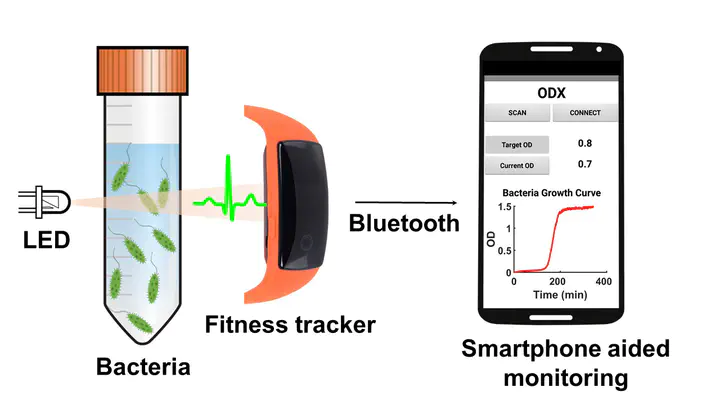 ODX, a fitness tracker based optical device for monitoring bacterial growth
ODX, a fitness tracker based optical device for monitoring bacterial growthBacterial growth measurement is important in a variety of industries and settings, including food processing, fermentation, and the production of biological products. There are various methods for measuring bacterial growth, including plate counting, direct counting, biomass measurement, and light scattering, but the gold standard is optical density measurement based on the scattering of light from bacterial cells. While spectrophotometers have traditionally been used for this purpose, they are costly, bulky, and require significant user interaction, making them less convenient and versatile.
In recent years, researchers have developed portable continuous bacterial growth monitoring devices based on optical density measurements, but these devices often require significant knowledge of sourcing materials and assembling them, and can cost upwards of $100. In order to overcome these challenges, we have developed ODX, an ultraportable, wireless, continuous bacterial growth measuring device that is capable of operating in any incubator-based setting and performing real-time, multi-parameter measurements of samples. ODX is based on a commercially available fitness tracker and can be remotely controlled using a smartphone app with a user-friendly GUI for data visualization.
ODX is designed to be low-cost, easy to use, and convenient for scientists working with bacteria. The device consists of a fitness tracker, a wireless transmitter, and a receiver unit. The fitness tracker is placed in the incubator with the bacteria and measures the optical density of the sample in real-time. The wireless transmitter sends the data to the receiver unit, which can be located outside of the incubator. The receiver unit is connected to a computer or smartphone, allowing the user to remotely control ODX and view the data in real-time.
ODX has several advantages over traditional methods of bacterial growth measurement. It is more convenient and easier to use than spectrophotometers, and it is also more portable and flexible, allowing it to be used in a variety of different settings. Additionally, ODX is less expensive than other portable bacterial growth monitoring devices, making it more accessible to a wider range of researchers.
To further evaluate the effectiveness of ODX, we conducted experiments with three different types of bacterial solutions. We compared the performance of ODX with a commercial spectrophotometer and found that ODX was able to accurately measure the optical density of the samples. We then conducted continuous bacterial growth monitoring tests, running experiments with each bacterial solution for more than 10 hours. The results, shown in the figure below, demonstrate that ODX was able to faithfully reproduce the bacterial growth curves.
Based on these results, we realized that this was more than just a hobby project and sought the advice of our supervisors on how to move forward. They suggested that we publish our results, which required a significant amount of effort in the form of writing a journal article that encompassed the various technologies and multidisciplinary approaches used in our work. Overall, our experiments have shown that ODX is a reliable and accurate tool for measuring bacterial growth, and we believe that it has the potential to greatly improve the efficiency and convenience of this important process.
ODX is an innovative device that has the potential to revolutionize the way scientists measure bacterial growth. Its low cost, ease of use, and portability make it an attractive option for researchers in a variety of industries and settings. We believe that ODX has the potential to greatly improve the efficiency and accuracy of bacterial growth measurement, and we are excited to see how it will be used in the future.
